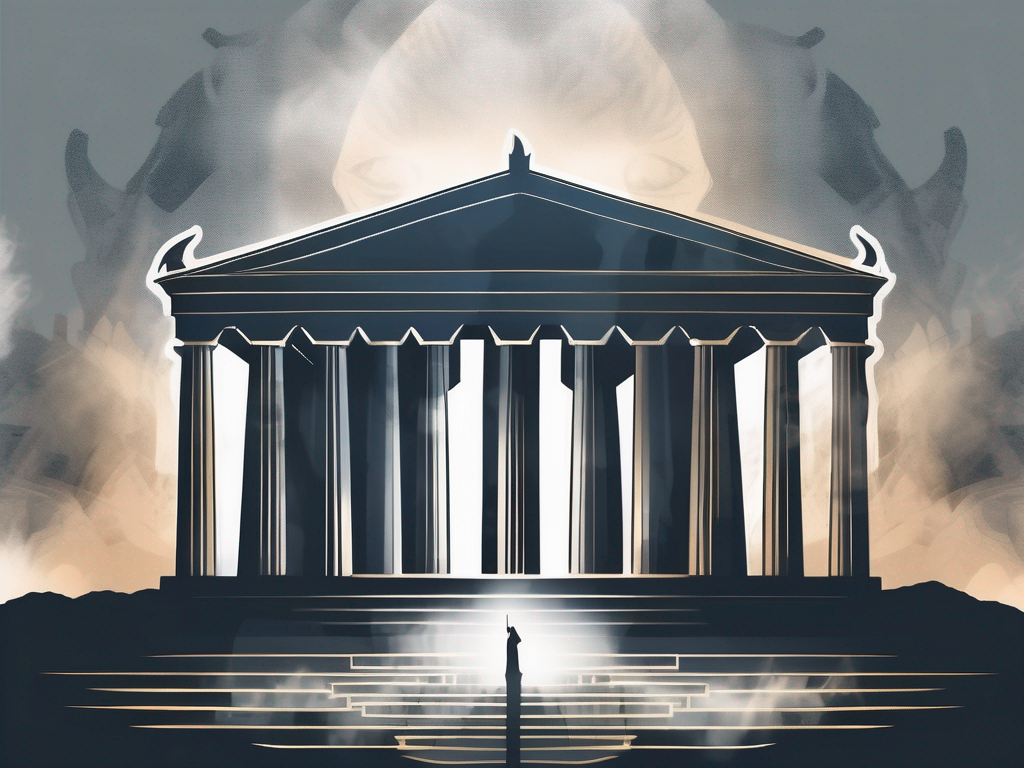In the vast pantheon of Egyptian deities, one figure stands out as a mighty creator and the embodiment of the sun’s radiant power: Atum. This revered god holds a prominent place in Egyptian mythology, with a rich tapestry of legends and myths woven around his name. Understanding the role of Atum in ancient Egypt requires delving into the ancient texts that depict his origin and exploring his significance in the Heliopolitan Ennead.
Understanding the Role of Atum in Egyptian Mythology
Atum, the self-created god, is believed to be the first entity to emerge from the primordial chaos. The ancient texts portray him as the ultimate creator, responsible for bringing the world into existence. According to one myth, Atum used his own power and will to form the land of Egypt from the watery abyss known as Nun. He also introduced the concept of time and established the order necessary for life to flourish.
But what exactly does it mean for Atum to be the “ultimate creator”? To fully grasp the significance of Atum’s role, we must delve into the intricate details of Egyptian mythology.
Ancient Egyptian religious texts provide fascinating insights into the origins of Atum. According to one creation myth, Atum emerged from the primordial waters of Nun in the form of a mound. This primordial mound symbolized the beginning of creation and the birthplace of all natural phenomena. It was from this mound that Atum, the self-created god, came into existence.
But Atum’s significance goes beyond his role as the creator of the world. These ancient texts also describe Atum as a hermaphroditic deity, embodying both male and female aspects. In some versions of the myth, Atum created the first divine couple, Shu and Tefnut, through his own self-fertilization. From Shu and Tefnut, all subsequent gods and all life forms emerged. This unique aspect of Atum’s nature adds another layer of complexity to his role in Egyptian mythology.
The Origin of Atum in Ancient Texts
The ancient religious texts of Egypt provide fascinating insights into the origins of Atum. According to one creation myth, Atum emerged from the primordial waters of Nun in the form of a mound. This primordial mound symbolized the beginning of creation and the birthplace of all natural phenomena.
These ancient texts also describe Atum as a hermaphroditic deity, embodying both male and female aspects. In some versions of the myth, Atum created the first divine couple, Shu and Tefnut, through his own self-fertilization. From Shu and Tefnut, all subsequent gods and all life forms emerged.
As the first entity to emerge from the chaos of Nun, Atum held a unique position in the Egyptian pantheon. He was seen as the original source of all existence, the one who brought order out of chaos. This made him a central figure in Egyptian cosmology and a deity of immense importance.
Atum’s Place in the Heliopolitan Ennead
As a member of the Heliopolitan Ennead, Atum shared the stage with other powerful deities such as Shu, Tefnut, Geb, Nut, Osiris, and Isis. This divine family played key roles in Egyptian cosmology and the unfolding of the earth’s creation and evolution. Atum was revered as the progenitor of these deities and the driving force behind their actions.
The Heliopolitan Ennead’s influence extended beyond religious practices. It shaped how the ancient Egyptians perceived their world, offering a framework through which they understood natural phenomena, such as the rising and setting of the sun or the annual flooding of the Nile. Atum’s presence in this pantheon solidified his status as a god of immense importance.
Understanding the role of Atum in Egyptian mythology requires a deep exploration of the ancient texts and the complex web of beliefs that shaped the religious and cultural landscape of ancient Egypt. Atum’s position as the self-created god and the ultimate creator of the world highlights his significance in the pantheon of Egyptian deities. His role as a hermaphroditic deity adds another layer of complexity to his character, reflecting the multifaceted nature of Egyptian mythology. As we continue to study and interpret these ancient texts, we gain a deeper understanding of the rich and intricate tapestry of Egyptian religious beliefs.
The Symbolism and Iconography of Atum
Depictions of Atum in ancient Egyptian art reveal the rich symbolism and iconography associated with this deity. Artists often portrayed Atum as a man wearing the double crown of Upper and Lower Egypt, signifying his dominion over the entire land. He is often depicted with the body of a human and the head of a cobra, linking him to the powers of protection and regeneration.
Depictions of Atum in Ancient Art
Ancient artworks incorporate various symbols to represent Atum. One prevalent symbol associated with him is the ankh, the ancient Egyptian hieroglyph for life. Atum is often depicted holding this symbol, illustrating his role as the giver and sustainer of life.
Another common depiction of Atum is as a solar disk with wings, known as the Atum bird. This symbolizes his connection to the sun and the power of creation. The Atum bird imagery often appears within magnificent temple murals and on sarcophagi, signifying Atum’s role in the journey of souls to the afterlife.
The Sun and Creation Symbols Associated with Atum
Atum’s association with the sun as a creator deity shaped the symbolism and admiration accorded to him. Just as the sun rises and sets each day, Atum was believed to move through the underworld during the night before being reborn at dawn. This cyclical journey represented his perpetual energy and the eternal cycle of life.
Scarabs, symbols of rebirth and transformation, were also closely linked to Atum. These sacred beetles were associated with the sun god because they roll dung balls in which they lay eggs. Just as a scarab rolls its ball, Atum was believed to roll the sun across the sky each day, ensuring its rebirth.
Atum’s Influence on Egyptian Religion and Culture
The impact of Atum on Egyptian religion and culture extends far beyond his role as a creator and sun deity. Worship of Atum permeated ancient Egyptian society, with dedicated temples and rituals honoring his divine power. Additionally, his influence on cosmology shaped the understanding of the world and its natural processes.
Worship and Temples of Atum
Throughout ancient Egypt, numerous temples were built to honor and venerate Atum. Pharaohs and commoners alike sought to show their devotion to this remarkable god. Many of these temples were located in Heliopolis, the epicenter of Atum worship.
One of the most significant temples devoted to Atum was the Temple of Atum in Heliopolis. This grand sanctuary was a focal point for priests and worshippers, where they practiced elaborate rituals and ceremonies to connect with the divine presence of Atum.
Atum’s Impact on Egyptian Cosmology
Atum’s role as the creator and sustainer of the universe profoundly influenced the ancient Egyptian understanding of cosmology. The belief in his power to bring forth the world legitimized the divine authority of pharaohs and the established order of the society.
The concept of ma’at, often translated as “truth” or “order,” was central to Egyptian cosmology and governed all aspects of life. Atum’s actions in creating the world and maintaining order reinforced the importance of upholding ma’at in daily life.
The Legends and Myths Surrounding Atum
Mythology abounds with captivating tales of Atum and his interactions with other prominent gods and goddesses. These legends provide insights into the complex relationships and narratives that shaped ancient Egyptian religious beliefs.
The Story of Atum’s Self-Creation
One of the most intriguing myths surrounding Atum is his self-creation. In this ancient story, Atum arises from the primordial waters of Nun to create the world. His act of self-creation symbolizes the inherent power and divinity within him, showcasing Atum’s status as a progenitor god.
This myth serves as a reminder of the Egyptians’ belief in self-renewal and the cyclical nature of life. Atum’s ability to bring forth creation from nothingness inspires individuals to embrace their own potential for growth and transformation.
Atum’s Role in the Myth of Osiris and Isis
The story of Atum’s role in the myth of Osiris and Isis adds further layers of complexity to his character. Osiris, the god of the afterlife, stands as Atum’s son and the rightful heir to his divine authority. Atum aids Osiris by guiding him through the underworld and assisting in his rebirth.
Atum’s involvement in this myth underscores his connection to life’s eternal cycle and the promise of resurrection. It solidifies his importance not only as a creator but also as a protector and guide in the journey to the afterlife.
Modern Interpretations and Influence of Atum
Egyptian mythology continues to captivate modern audiences, and Atum’s presence endures in literature, media, and the field of Egyptology. Contemporary interpretations of Atum’s character breathe new life into ancient stories and reinforce his lasting significance in both historical and popular contexts.
Atum in Contemporary Literature and Media
Atum’s compelling mythology has found a home in contemporary literature and media, where writers and filmmakers draw upon ancient stories to weave tales of adventure and intrigue. Through these modern adaptations, Atum’s power as a creator and his association with the sun resonate with new generations.
Furthermore, Atum’s image and symbols continue to inspire artists and designers, appearing in various forms of visual media, from fashion to video games. His enduring influence ensures that the legacy of Atum remains vibrant in popular culture.
The Continued Significance of Atum in Modern Egyptology
The field of Egyptology has dedicated scholars and researchers to the study of ancient Egypt and its myths, shining a light on the religious beliefs of the past. Atum remains central to these investigations, as scholars strive to uncover more about his origin, symbolism, and place within Egyptian society.
By delving deeper into the enigmatic world of Atum, researchers gain a greater understanding of the complex religious and cultural practices that shaped ancient Egypt. This ongoing pursuit ensures that Atum’s legacy endures, allowing future generations to marvel at the wonders of this captivating deity.
In conclusion, Atum, the Egyptian god of creation and the sun, stands as a powerful figure in ancient Egyptian mythology. His role as a creator and his association with the sun’s radiant power solidify his significance within the pantheon of Egyptian deities. From his self-creation to his involvement in the myths of Osiris and Isis, Atum’s stories continue to captivate and inspire. His influence on Egyptian religion and culture remains evident, both in the worship dedicated to him and in the ancient cosmological beliefs he helped shape. Today, Atum’s presence endures in literature, media, and the enduring curiosity of Egyptologists. The legacy of Atum serves as a testament to the enduring power of ancient myths and the human fascination with creation and transcendence.












